
The Master Key: An Electrical Fairy Tale, Founded Upon the Mysteries of Electricity and the Optimism of Its Devotees is a 1901 novel by L. Frank Baum, author of The Wonderful Wizard of Oz . It was illustrated by F. Y. Cory. [1]

The Master Key: An Electrical Fairy Tale, Founded Upon the Mysteries of Electricity and the Optimism of Its Devotees is a 1901 novel by L. Frank Baum, author of The Wonderful Wizard of Oz . It was illustrated by F. Y. Cory. [1]
The protagonist is a boy named Rob Joslyn. His age is not specified. Baum dedicated the book "To My Son, Robert Stanton Baum," who was born in 1886 and would thus have been about fifteen at the time it was published.
Rob is an electrical experimenter whose father encourages him and sees that he "never lacked batteries, motors or supplies of any sort." A "net-work[sic] of wires soon ran throughout the house". He loses track of the elaborately interconnected wires, and trying to get a cardboard house to light up, he "experimented in a rather haphazard fashion, connecting this and that wire blindly and by guesswork, in the hope that he would strike the right combination." There is a bright flash, and a being who calls himself the Daemon of Electricity appears. He tells Rob that he has accidentally "touched the Master Key of Electricity" and is entitled "to demand from me three gifts each week for three successive weeks." Rob protests that he does not know what to ask for, and the Daemon agrees to select the gifts himself.
Over the next two weeks, Rob experiences adventures exploring the use of the Daemon's gifts, but eventually concludes that neither he nor the world is ready for them. On the third week, Rob rejects the Daemon's gifts and tells him to bide his time until humankind knows how to use them. The Daemon leaves. With a light heart, Rob concludes that he made the right decision.
During the first week, the Daemon gives Rob three gifts:
During the second week, the Daemon gives Rob three additional gifts:
During the third week, the Daemon offered:
Like some of Baum's adult novels, The Master Key features encounters with real historical figures of the period, such as King Edward of Britain, President Loubet of France, and the Duke of Orléans.
In 1901, The New York Times ran a brief notice calling it "a story for boys—all boys who love good wholesome adventure and exciting incident. It is a strange story of the electrical Daemon, treating of powers that dominate all nature, and written for the eager, alert, and striving American boy." [2]

Electricity is the set of physical phenomena associated with the presence and motion of matter that has a property of electric charge. Electricity is related to magnetism, both being part of the phenomenon of electromagnetism, as described by Maxwell's equations. Various common phenomena are related to electricity, including lightning, static electricity, electric heating, electric discharges and many others.
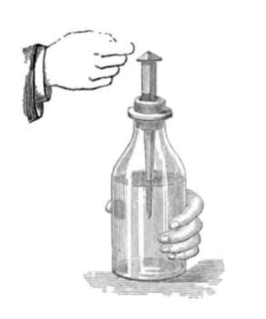
A Leyden jar is an electrical component which stores a high-voltage electric charge between electrical conductors on the inside and outside of a glass jar. It typically consists of a glass jar with metal foil cemented to the inside and the outside surfaces, and a metal terminal projecting vertically through the jar lid to make contact with the inner foil. It was the original form of the capacitor.
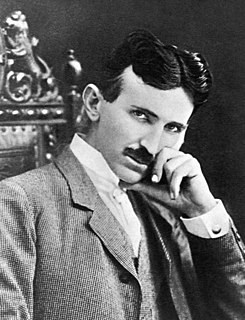
Nikola Tesla was a Serbian-American inventor, electrical engineer, mechanical engineer, and futurist best known for his contributions to the design of the modern alternating current (AC) electricity supply system.
Timeline of electromagnetism and classical optics lists, within the history of electromagnetism, the associated theories, technology, and events.

Sir Charles Wheatstone FRS FRSE DCL LLD, was an English scientist and inventor of many scientific breakthroughs of the Victorian era, including the English concertina, the stereoscope, and the Playfair cipher. However, Wheatstone is best known for his contributions in the development of the Wheatstone bridge, originally invented by Samuel Hunter Christie, which is used to measure an unknown electrical resistance, and as a major figure in the development of telegraphy.

Wardenclyffe Tower (1901–1917), also known as the Tesla Tower, was an early experimental wireless transmission station designed and built by Nikola Tesla on Long Island in 1901–1902, located in the village of Shoreham, New York. Tesla intended to transmit messages, telephony and even facsimile images across the Atlantic to England and to ships at sea based on his theories of using the Earth to conduct the signals. His decision to scale up the facility and add his ideas of wireless power transmission to better compete with Guglielmo Marconi's radio based telegraph system was met with refusal to fund the changes by the project's primary backer, financier J. P. Morgan. Additional investment could not be found, and the project was abandoned in 1906, never to become operational.

Ayla Ranzz, known originally as Lightning Lass is a comic book fictional character, who is a super heroine in a future DC Comics universe. She is a member of the Legion of Super-Heroes.

The Life and Adventures of Santa Claus is a 1902 children's book, written by L. Frank Baum and illustrated by Mary Cowles Clark.
Electrochemistry, a branch of chemistry, went through several changes during its evolution from early principles related to magnets in the early 16th and 17th centuries, to complex theories involving conductivity, electric charge and mathematical methods. The term electrochemistry was used to describe electrical phenomena in the late 19th and 20th centuries. In recent decades, electrochemistry has become an area of current research, including research in batteries and fuel cells, preventing corrosion of metals, the use of electrochemical cells to remove refractory organics and similar contaminants in wastewater electrocoagulation and improving techniques in refining chemicals with electrolysis and electrophoresis.
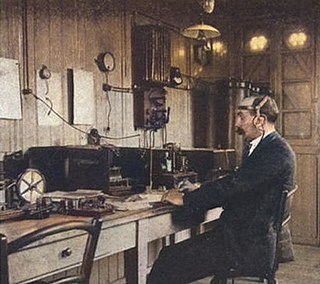
The invention of radio communication spanned many decades of experimental investigation of radio waves, establishment of theoretical underpinnings, engineering and technical developments, and adaptation to signaling. The work of many scientists culminated in the building of an engineering complete and commercially successful wireless communication system by Guglielmo Marconi, who is usually credited as the inventor of radio.

The history of electromagnetic theory begins with ancient measures to understand atmospheric electricity, in particular lightning. People then had little understanding of electricity, and were unable to explain the phenomena. Scientific understanding into the nature of electricity grew throughout the eighteenth and nineteenth centuries through the work of researchers such as Coulomb, Ampère, Faraday and Maxwell.

Robert J. Kuntz is a game designer and author of role-playing game publications. He is best known for his contributions to various Dungeons & Dragons-related materials.

A dynamo is an electrical generator that creates direct current using a commutator. Dynamos were the first electrical generators capable of delivering power for industry, and the foundation upon which many other later electric-power conversion devices were based, including the electric motor, the alternating-current alternator, and the rotary converter.
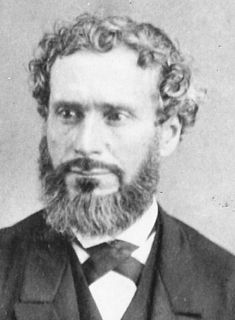
Charles Grafton Page was an American electrical experimenter and inventor, physician, patent examiner, patent advocate, and professor of chemistry.

Mahlon Loomis was an American dentist and inventor. He is best known for promoting the idea that the Earth's upper atmosphere was divided into discrete concentric layers, and these layers could be tapped by metallic conductors on hills and mountain tops, in order to provide long-distance wireless telegraph and telephone communication, as well as draw electricity down to the Earth's surface.

The World Wireless System was a turn of the 20th century proposed telecommunications and electrical power delivery system designed by inventor Nikola Tesla based on his theories of using Earth and its atmosphere as electrical conductors. He claimed this system would allow for "the transmission of electric energy without wires" on a global scale as well as point-to-point wireless telecommunications and broadcasting. He made public statements citing two related methods to accomplish this from the mid-1890s on. By the end of 1900 he had convinced banker J. P. Morgan to finance construction of a wireless station based on his ideas intended to transmit messages across the Atlantic to England and to ships at sea. His decision to change the design to include wireless power transmission to better compete with Guglielmo Marconi's new radio based telegraph system was met with Morgan's refusal to fund the changes. The project was abandoned in 1906, never to become operational.

The Pulvermacher chain, or in full as it was sold the Pulvermacher hydro-electric chain, was a type of voltaic battery sold in the second half of the 19th century for medical applications. Its chief market was amongst the numerous quack practitioners who were taking advantage of the popularity of the relatively new treatment of electrotherapy, or "electrification" as it was then known. Its unique selling point was its construction of numerous linked cells, rendering it mechanically flexible. A variant intended to be worn wrapped on part of the body for long periods was known as Pulvermacher's galvanic chain or electric belt.

The kite experiment is a scientific experiment in which a kite with a pointed, conductive wire attached to its apex is flown near thunder clouds to collect electricity from the air and conduct it down the wet kite string to the ground. It was proposed and may have been conducted by Benjamin Franklin with the assistance of his son William Franklin. The experiment's purpose was to uncover the unknown facts about the nature of lightning and electricity, and with further experiments on the ground, to demonstrate that lightning and electricity were the result of the same phenomenon.
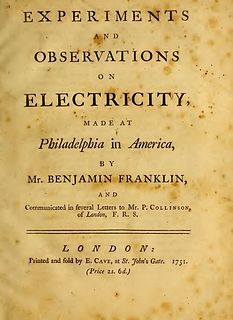
Experiments and Observations on Electricity is a mid-eighteenth century book consisting of letters from Benjamin Franklin. These letters concerned Franklin's discoveries about the behavior of electricity based on experimentation and scientific studies. The book came in pamphlet form for the first three English editions. The last two editions were in a book volume with hard covers and a book spine. There were eleven European editions of the book: five English editions, three French editions, and a German, Italian and Latin edition. The publication was well received worldwide. It was considered America's most important scientific book of the eighteenth century.

Franklin's electrostatic machine is a high-voltage static electricity-generating device used by Benjamin Franklin in the mid-18th century for research into electrical phenomena. Its key components are a glass globe which turned on an axis via a crank, a cloth pad in contact with the spinning globe, a set of metal needles to conduct away the charge developed on the globe by its friction with the pad, and a Leyden jar – a high-voltage capacitor – to accumulate the charge. Franklin's experiments with the machine eventually led to new theories about electricity and inventing the lightning rod.